Do you have a question about the Ericsson BusinessPhone 250 and is the answer not in the manual?
Official title and user guide designation for the product.
Console's primary output screen for information and prompts.
Keys that control menu navigation and access functions displayed on screen.
Keys for storing numbers and functions, including headset key.
Keys like Clear, Speech, Monitor, Notify for call handling.
Keys for Off Duty, Volume Control, Mute.
Microphone, Loudspeaker, Handset with hearing aid.
Expandable key panels providing additional programmable keys.
Reroutes incoming calls to an alternative answering position when activated.
Switches the system to night mode, routing calls to a defined position.
Display shows internal caller number/name or external caller number.
How to answer calls using the handset or handsfree.
Mutes the ringer for incoming calls, indicated only on display.
Procedures for dialling extension numbers or using pre-programmed keys.
Procedures for accessing external lines and dialling numbers.
System automatically redials a number if busy or no answer.
Options for transferring or camp-on calls to busy extensions.
Procedures for transferring calls to extensions, with/without announcement.
Putting calls on hold for operator or individual use, and retaking them.
Establishing and managing three-party conferences.
Ordering external lines with dial tone for other extensions.
Procedures for ordering calls while remaining on or off the line.
Procedures for ordering calls where the caller does not remain on the line.
How to get information about diverted calls.
Procedure to bypass diversion for urgent calls.
Activating, cancelling, and changing internal/external diversion addresses.
Pre-defined text, voice, and free text information for extensions.
Step-by-step process to add information to an extension.
Selecting and entering predefined absence reasons and return times.
Setting and managing passwords for the message system.
Direct, call-back, voice, or text messages to extensions.
Checking returned, sent, and received messages; storing messages.
Activating and deactivating the common mailbox for messages.
Accessing mailbox messages internally or externally.
Common vs. individual abbreviated numbers for faster calling.
Storing numbers or dial codes on programmable keys.
Programming and using keys to call by name.
Displaying the cost of the most recent outgoing external call.
Checking own or others' call costs and accumulated pulses.
Reading out counter values before system reconfigurations.
Broadcasting voice messages to a group of extensions.
Monitoring group member status and handling calls for the group.
Logging in and out of hunt groups to answer calls.
Placing external call costs onto specific account numbers.
Providing voice instructions for callers to reach destinations.
Setting timed reminders for oneself.
Preventing unauthorized use of the telephone.
Selecting and managing a four-digit password for security functions.
Temporarily bypassing blocked extensions using a password.
Automatically selecting the cheapest connection for external calls.
Dialling an LCR code before an external number for cost savings.
Displaying caller and called party numbers on digital lines.
Handling incoming calls from ISDN lines.
Establishing external calls on ISDN lines.
Adding more programmable keys to the telephone.
Using headsets for handsfree calls and group listening.
Assigning functions and short numbers to programmable keys.
Configuring the ringing pattern for incoming calls.
Reference table for function codes and associated data.
Understanding the structure and fields of the tiltable display.
Interpreting abbreviations and codes shown on the display.
Understanding the meaning of different key lamp states.
Customizing answer mode, extend mode, and signalling mode.
Adjusting volume levels for calls and music.
Configuring ringing type, volume, and character.
Descriptions and waveforms of various system tones.
Descriptions of internal and external ringing signal patterns.
Using the keypad to input text for messages or directory searches.
Considerations for using multiple external lines for calls/conferences.
Connecting handset, exchange line, and optional components.
Guidelines for positioning and maintaining the telephone.
Alphabetical list of terms and their explanations.
Information on software and hardware requirements for the toolbox.
Description of a pocket guide for the integrated mailbox system.
Official title and user guide designation for the product.
Console's primary output screen for information and prompts.
Keys that control menu navigation and access functions displayed on screen.
Keys for storing numbers and functions, including headset key.
Keys like Clear, Speech, Monitor, Notify for call handling.
Keys for Off Duty, Volume Control, Mute.
Microphone, Loudspeaker, Handset with hearing aid.
Expandable key panels providing additional programmable keys.
Reroutes incoming calls to an alternative answering position when activated.
Switches the system to night mode, routing calls to a defined position.
Display shows internal caller number/name or external caller number.
How to answer calls using the handset or handsfree.
Mutes the ringer for incoming calls, indicated only on display.
Procedures for dialling extension numbers or using pre-programmed keys.
Procedures for accessing external lines and dialling numbers.
System automatically redials a number if busy or no answer.
Options for transferring or camp-on calls to busy extensions.
Procedures for transferring calls to extensions, with/without announcement.
Putting calls on hold for operator or individual use, and retaking them.
Establishing and managing three-party conferences.
Ordering external lines with dial tone for other extensions.
Procedures for ordering calls while remaining on or off the line.
Procedures for ordering calls where the caller does not remain on the line.
How to get information about diverted calls.
Procedure to bypass diversion for urgent calls.
Activating, cancelling, and changing internal/external diversion addresses.
Pre-defined text, voice, and free text information for extensions.
Step-by-step process to add information to an extension.
Selecting and entering predefined absence reasons and return times.
Setting and managing passwords for the message system.
Direct, call-back, voice, or text messages to extensions.
Checking returned, sent, and received messages; storing messages.
Activating and deactivating the common mailbox for messages.
Accessing mailbox messages internally or externally.
Common vs. individual abbreviated numbers for faster calling.
Storing numbers or dial codes on programmable keys.
Programming and using keys to call by name.
Displaying the cost of the most recent outgoing external call.
Checking own or others' call costs and accumulated pulses.
Reading out counter values before system reconfigurations.
Broadcasting voice messages to a group of extensions.
Monitoring group member status and handling calls for the group.
Logging in and out of hunt groups to answer calls.
Placing external call costs onto specific account numbers.
Providing voice instructions for callers to reach destinations.
Setting timed reminders for oneself.
Preventing unauthorized use of the telephone.
Selecting and managing a four-digit password for security functions.
Temporarily bypassing blocked extensions using a password.
Automatically selecting the cheapest connection for external calls.
Dialling an LCR code before an external number for cost savings.
Displaying caller and called party numbers on digital lines.
Handling incoming calls from ISDN lines.
Establishing external calls on ISDN lines.
Adding more programmable keys to the telephone.
Using headsets for handsfree calls and group listening.
Assigning functions and short numbers to programmable keys.
Configuring the ringing pattern for incoming calls.
Reference table for function codes and associated data.
Understanding the structure and fields of the tiltable display.
Interpreting abbreviations and codes shown on the display.
Understanding the meaning of different key lamp states.
Customizing answer mode, extend mode, and signalling mode.
Adjusting volume levels for calls and music.
Configuring ringing type, volume, and character.
Descriptions and waveforms of various system tones.
Descriptions of internal and external ringing signal patterns.
Using the keypad to input text for messages or directory searches.
Considerations for using multiple external lines for calls/conferences.
Connecting handset, exchange line, and optional components.
Guidelines for positioning and maintaining the telephone.
Alphabetical list of terms and their explanations.
Information on software and hardware requirements for the toolbox.
Description of a pocket guide for the integrated mailbox system.
| Handsfree | Yes |
|---|---|
| Wall mountable | Yes |
| Speed Dial | Yes |
| Caller ID | Yes |
| Conference | Yes |
| Headset Port | Yes |
| Volume Control | Yes |
| Type | Digital Telephone |
| Display | Alphanumeric LCD |
| Power Supply | Via PBX system |

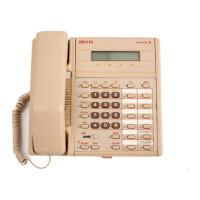

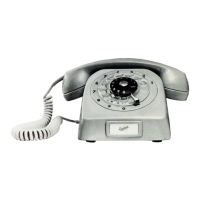
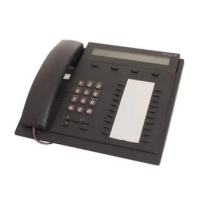

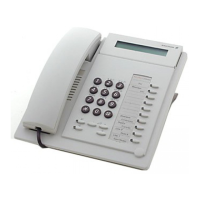

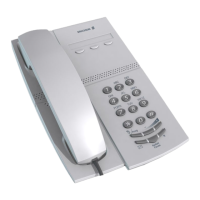
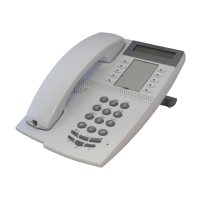

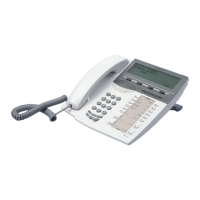
